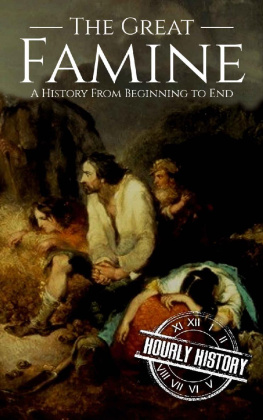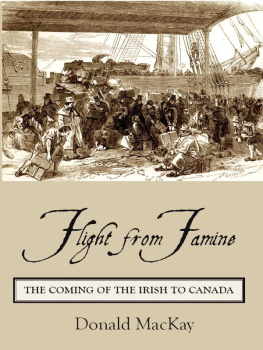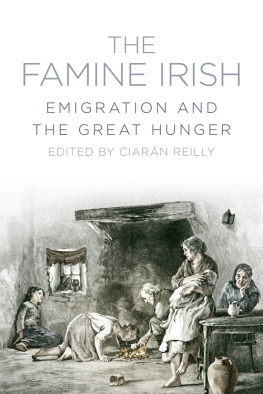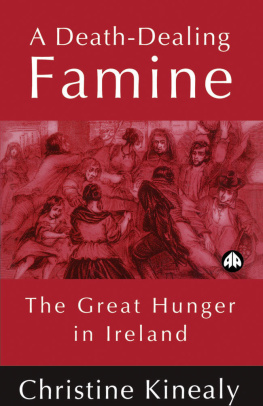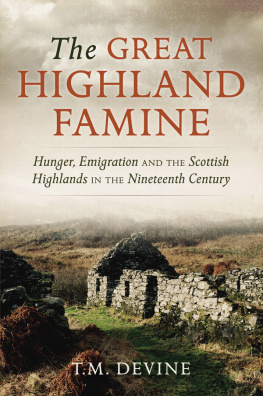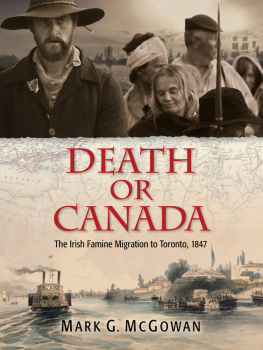JIM REES, a Wicklow resident and historian, with a History Masters Degree from NUI Maynooth, has had a lifelong passion for history and literature. He has written extensively and lectured widely on topics such as emigration and maritime history.
Keep up to date with Jim Rees on Facebook at www.facebook.com/jim.rees.391?fref=ts
CONTENTS
The publishers and author would like to thank all who have supplied illustrations for this book.
Page 10: Trustees of the Right Honourable Olive, Countess Fitzwilliams Chattels Settlement and Lady Juliet de Chair.
Page 14: William Nolan, Geography Publications.
Pages 45, 48, 50, 52, 54: Illustrated London News.
Pages 60, 62, 72, 74: Andr Charbonneau, Parcs Canada.
Page 84: Robbie Tyrrell.
Page 143: The outboard sketch of the barque Dunbrody, Colin Mudie.
I began researching this book in 1995 and it took about three years to complete. I was fortunate to receive the help and goodwill of many people during that time. I wish to thank the Director and staff of the National Library of Ireland; Brian Donnelly and Ken Hannigan of the National Archives of Ireland; Billy Lee, John Murphy, Joe Hayden, the late Paudge Brennan, Pat Power, Mary Kelly Quinn, and Richard Haworth. Mary Byrne deciphered many of the documents and put them on computer.
I must mention the generous help and co-operation of Denis Noel of the Provincial Archives of New Brunswick, Allen Doiron also of the PANB, Mary McDevitt the Archivist of the Diocese of St John, Professor Gail Campbell of St Thomas University, George Haney, Joan Jones, Anne Brault, Hilarion and Patricia Coughlin, and all the members of the Irish Canadian Cultural Association who helped in so many ways. I must thank Marianna OGallagher in Quebec and Tom and Mary-Anne Birchard, Kyle, Meghan, and Garrett in Toronto. Among my informants were descendants of some of the emigrants whose story is recorded here. I am particularly grateful to Ron Brash, Paul Ormond, Terri Brickett, Marian Gamester, Bob Beckwith and Gail Nightingale. Both Lois Long of Ottawa and Ross Hopkins of Rossland, BC, deserve very special mention for supplying me not only with information about their ancestors but also for sharing the fruits of their very extensive researches.
Without financial support, I could not have undertaken research in Canada. In this regard special thanks are due to the OMahony family who provided research funding through the EOIN OMAHONY BURSARY, which is administered by the Royal Irish Academy.
Below is a table of modern equivalents of the main contemporary monetary amounts mentioned in the text. Finding an appropriate indicator to compare relative worth is a complex business, as there are many and varied methods from which to choose, and the result is, of necessity, merely an approximation. I have used a comparison of average earnings as the basis, from the website MeasuringWorth.com.
| 18471856 | 2010s |
| Five shillings | 200 |
| Ten shillings | 400 |
| 3-15-0 | 3,000 |
| 5 | 4,000 |
| 10-15-0 | 9,000 |
| 20 | 17,000 |
| 40-5-6 | 33,000 |
| 3,000 | 2.6 million |
| 16,342-11-1 | 14 million |
| 24,000 | 20 million |
The Irish potato famine of the second half of the 1840s was a catastrophe of immense proportions. It has been described as the worst social disaster of nineteenth-century Europe. Its scale was so vast that historians disagree on many of its aspects. How many died, how many emigrated, how much or how little was done by government to alleviate the suffering of millions; how great was its social and cultural impact? Was it famine or simply a series of crop failures? Was it the will of God or passive genocide? They cannot even agree on how long it lasted. Its duration is difficult to define because it did not end but rather petered out, with some regions experiencing crop failures for seven consecutive years from 1845 to 1852.
So much has been written about that horrific time that it is sometimes tempting to think that there are no new angles from which to view it. That would be a great mistake. As historians dig deeper, new facts leading to new interpretations come to light. Also, when an event of such magnitude is looked at on a national level, the overall picture can only be brought into focus at the loss of localised detail. The potato crop failures of those years varied in intensity and geographical distribution and there has been an understandable tendency to concentrate on those areas which were hardest hit. Because of this tendency many parts of the country have been overlooked or, at best, only briefly referred to.
One of those regions is County Wicklow which, in common with most of the eastern counties, figures scantily, if at all, in most of the major studies. This meagre coverage is unintentionally misleading and perpetuates the misconception that Wicklow somehow managed to come through those years unscathed.
Recent studies have shown that death from starvation and disease in Wicklow was more common than had been realised.
Landlords, eager to rid their estates of surplus tenantry, were engaged in assisted passages. The most important of these was Lord Fitzwilliam, whose 80,000-acre estate was by far the largest in the county. Between 1847 and 1856 he removed almost 6,000 men, women and children from his property and arranged passage for them to Canada. Most of them were destitute and arrived in Quebec and New Brunswick with little more than what they wore on their backs.
The purpose of this study is to examine the Fitzwilliam clearances during those years and, where possible, to see how some of the families fared on their arrival in Canada. It will be noticed that while a complete chapter is dedicated to the situation on the infamous Grosse le near Quebec, there is little information in this work about how these families fared when they reached their destinations in Ontario and elsewhere. This was due to time and financial restrictions during the research period. However, I have included a detailed chapter dealing with those families who arrived in St Andrews, New Brunswick.
Coolattin is synonymous with the Fitzwilliam family, who owned the property for 200 years before selling it in the 1970s.
The district in which the Coolattin estate lay was once part of the lands controlled by the native Irish sept of the OByrnes. Although there is evidence to show that the Normans made some attempt to settle the area, it was not until the sixteenth century that English influence was eventually felt. In 1578, Sir Henry Harrington, an adventurer, was granted the country of Shilelaughe alias Shilealie in County Dublin,
This was hostile country for people like Harrington and one of the stipulations of the lease was that he had to maintain a corps of English horsemen. The indigenous inhabitants were, understandably, sometimes less than compliant with leases that had been drawn up without their consultation. Harrington immediately set about building a stone castle in the townland of Knockloe. It did little to deter the OByrnes from registering their displeasure at his intrusion and they razed it in a subsequent battle in 1597. Equally undeterred, Harrington built another castle a few years later at Carnew. This one withstood the test of time and tumult and a substantial portion of it, incorporated into a more recent building, can still be seen in the village.


